Chapter: Medical Physiology: Electrocardiographic Interpretation of Cardiac Muscle and Coronary Blood Flow Abnormalities: Vectorial Analysis
Principles of Vectorial Analysis of Electrocardiograms
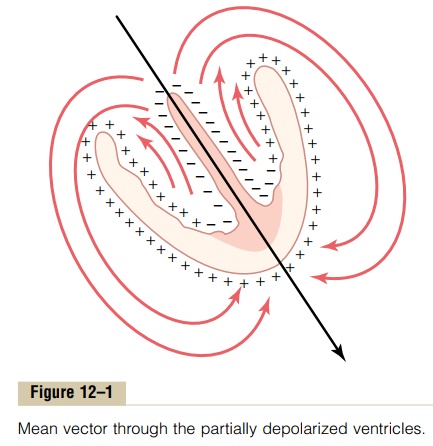
Principles of Vectorial Analysis of Electrocardiograms
Use of Vectors to Represent Electrical Potentials
Before it is possible to understand how cardiac abnormalities affect the con-tours of the electrocardiogram, one must first become thoroughly familiar with the concept of vectors and vectorial analysis as applied to electrical potentials in and around the heart.
Several times it was pointed out that heart current flows in a particular direction in the heart at a given instant during the cardiac cycle. A vector is an arrow that points in the direction of the electrical potential gener-ated by the current flow, with the arrowhead in the positive direction. Also, by convention, the length of the arrow is drawn proportional to the voltage of thepotential.
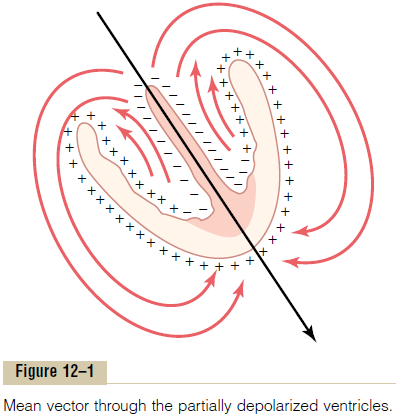
“Resultant” Vector in the Heart at Any Given Instant. Figure 12–1 shows, by the shadedarea and the negative signs, depolarization of the ventricular septum and parts of the apical endocardial walls of the two ventricles. At this instant of heart exci-tation, electrical current flows between the depolarized areas inside the heart and the nondepolarized areas on the outside of the heart, as indicated by the long elliptical arrows. Some current also flows inside the heart chambers directly from the depolarized areas toward the still polarized areas. Overall, consider-ably more current flows downward from the base of the ventricles toward the apex than in the upward direction. Therefore, the summated vector of the gen-erated potential at this particular instant, called the instantaneous mean vector, is represented by the long black arrow drawn through the center of the ventri-cles in a direction from base toward apex. Furthermore, because the summated current is considerable in quantity, the potential is large, and the vector is long.
Direction of a Vector Is Denoted in Terms of Degrees
When a vector is exactly horizontal and directed toward the person’s left side, the vector is said to extend in the direction of 0 degrees, as shown in Figure
From this zero reference point, the scale of vectors rotates clockwise: when the vector extends from above and straight downward, it has a direction of +90 degrees; when it extends from the person’s left to right, it has a direction of +180 degrees; and when it extends straight upward, it has a direction of -90 (or +270) degrees.
In a normal heart, the average direction of the vector during spread of the depolarization wave through the ventricles, called the mean QRS vector, is about +59 degrees, which is shown by vector A drawn
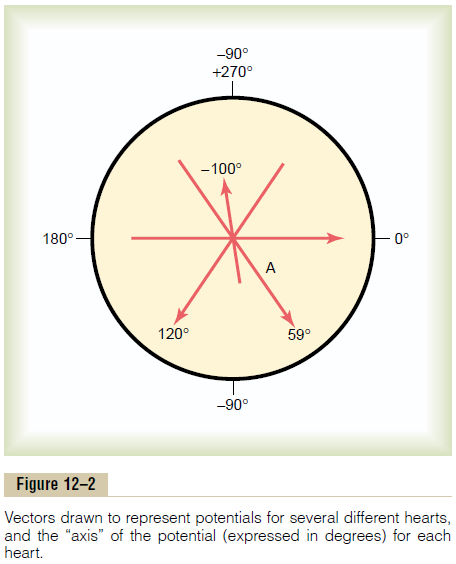
through the center of Figure 12–2 in the +59-degree direction. This means that during most of the depolar-ization wave, the apex of the heart remains positive with respect to the base of the heart.
Axis for Each Standard Bipolar Lead and Each Unipolar Limb Lead
The three standard bipolar and the three unipolar limb leads are described. Each lead is actu-ally a pair of electrodes connected to the body on opposite sides of the heart, and the direction from neg-ative electrode to positive electrode is called the “axis” of the lead. Lead I is recorded from two electrodes placed respectively on the two arms. Because the elec-trodes lie exactly in the horizontal direction, with the positive electrode to the left, the axis of lead I is 0 degrees.
In recording lead II, electrodes are placed on the right arm and left leg. The right arm connects to the torso in the upper right-hand corner and the left leg connects in the lower left-hand corner. Therefore, the direction of this lead is about +60 degrees.
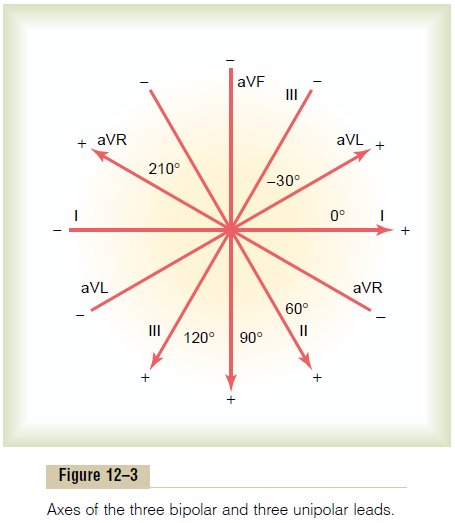
By similar analysis, it can be seen that lead III has an axis of about +120 degrees; lead aVR, +210 degrees; aVF, +90 degrees; and aVL -30 degrees. The directions of the axes of all these leads are shown in Figure 12–3, which is known as the hexagonal reference system. The polarities of the electrodes are shown by the plus and minus signs in the figure. The reader must learn theseaxes and their polarities, particularly for the bipolar limb leads I, II, and III, to understand the remainder.
Vectorial Analysis of Potentials Recorded in Different Leads
Now that we have discussed, first, the conventions for representing potentials across the heart by means of vectors and, second, the axes of the leads, it is possible to use these together to determine the instantaneous potential that will be recorded in the electrocardio-gram of each lead for a given vector in the heart, as follows.
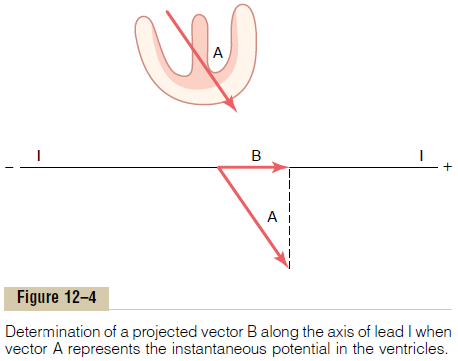
Figure 12–4 shows a partially depolarized heart; vector A represents the instantaneous mean direction of current flow in the ventricles. In this instance, the direction of the vector is +55 degrees, and the voltage of the potential, represented by the length of vector A, is 2 millivolts. In the diagram below the heart, vector A is shown again, and a line is drawn to represent theaxis of lead I in the 0-degree direction. To determine how much of the voltage in vector A will be recorded in lead I, a line perpendicular to the axis of lead I is drawn from the tip of vector A to the lead I axis, and a so-called projected vector (B) is drawn along the lead I axis. The arrow of this projected vector points toward the positive end of the lead I axis, which means that the record momentarily being recorded in the electro-cardiogram of lead I is positive. And the instantaneous recorded voltage will be equal to the length ofB divided by the length of A times 2 millivolts, or about 1 millivolt.
Figure 12–5 shows another example of vectorial analysis. In this example, vector A represents the elec-trical potential and its axis at a given instant during ventricular depolarization in a heart in which the left side of the heart depolarizes more rapidly than the right. In this instance, the instantaneous vector has a direction of 100 degrees, and its voltage is again 2 mil-livolts. To determine the potential actually recorded in lead I, we draw a perpendicular line from the tip of vector A to the lead I axis and find projected vector B. Vector B is very short and this time in the negative direction, indicating that at this particular instant, the recording in lead I will be negative (below the zero line
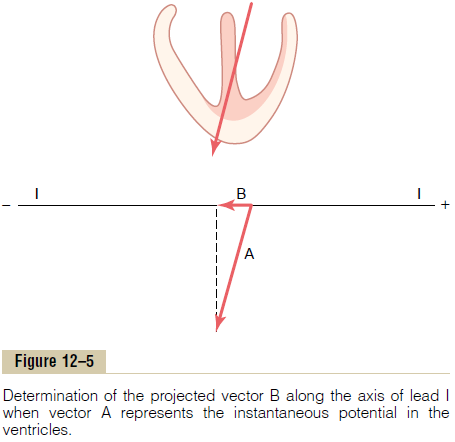
in the electrocardiogram), and the voltage recorded will be slight, about -0.3 millivolts. This figure demon-strates that when the vector in the heart is in a direc-tion almost perpendicular to the axis of the lead, the voltage recorded in the electrocardiogram of this lead is very low. Conversely, when the heart vector has almost exactly the same axis as the lead axis, essentially the entire voltage of the vector will be recorded.
Vectorial Analysis of Potentials in the Three Standard Bipolar Limb Leads. In Figure 12–6, vectorAdepicts the instantaneous electrical potential of a partially depo-larized heart. To determine the potential recorded at this instant in the electrocardiogram for each one of the three standard bipolar limb leads, perpendicular lines (the dashed lines) are drawn from the tip of vector A to the three lines representing the axes of the three different standard leads, as shown in the figure. The projected vector B depicts the potential recorded at that instant in lead I, projected vector C depicts the potential in lead II, and projected vector D depicts the potential in lead III. In each of these, the record in the electrocardiogram is positive—that is, above the zero line—because the projected vectors point in the positive directions along the axes of all the leads. The potential in lead I (vector B) is about one half that of the actual potential in the heart (vector A); in lead II (vector C), it is almost equal to that in the heart; and in lead III (vector D), it is about one third that in the heart.
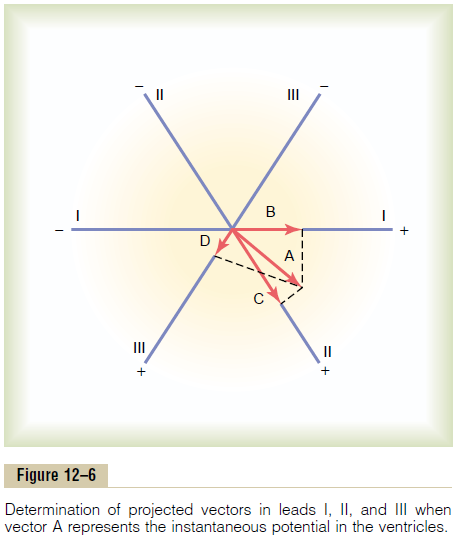
An identical analysis can be used to determine potentials recorded in augmented limb leads, except that the respective axes of the augmented leads (see Figure 12–3) are used in place of the standard bipolar limb lead axes used for Figure 12–6.

Related Topics